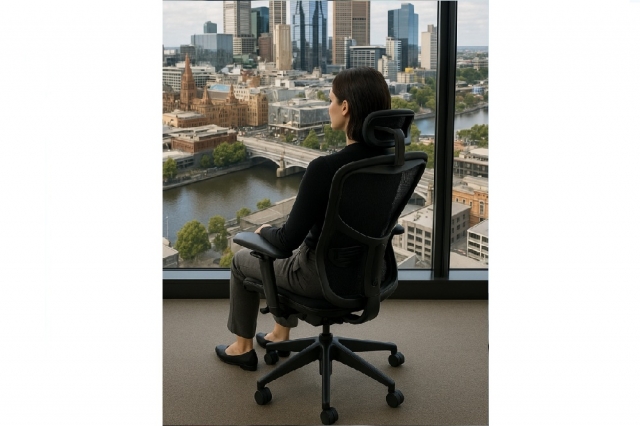As Australian businesses, government departments and educators navigate the shift towards hybrid and remote work, one factor has taken centre stage: the workspace itself. It’s no longer just about where we work—but how well that environment supports our performance and wellbeing.
Professionals across Australia are now rethinking their office setups, both in corporate buildings and at home. Ergonomics—the science of designing a workspace that fits the user—has emerged as a crucial driver of productivity, focus, and even mental clarity. This article explores how smarter office furniture and layout choices can deliver tangible benefits for today’s evolving workforce.
The Productivity–Posture Connection
The link between comfort and output isn’t just anecdotal. Studies show that poor ergonomic design can lead to fatigue, reduced concentration, and musculoskeletal issues—particularly for those spending six or more hours at a desk.
In contrast, an intelligently designed workstation enables professionals to work longer, think clearer, and experience fewer physical complaints. It's why major employers and educational institutions are investing in adjustable furniture, tailored setups, and wellness-focused office policies.
From Corporates to Classrooms: The Australian Context
In Australia, the conversation around workplace ergonomics is expanding. Beyond big-city corporates, regional councils, universities, and small businesses are starting to prioritise ergonomic interventions. The Australian Work Health and Safety Strategy highlights this shift, promoting physical and psychological health in the workplace.
Remote work—once a rare perk—is now standard for many roles. With more Australians working from spare bedrooms, kitchen tables, and even patios, the risks of non-ergonomic setups have grown. Many employees are unknowingly compromising their health with makeshift furniture or incorrect monitor positioning.
The Core Elements of Smarter Office Design
- Supportive Chairs That Do the Heavy Lifting
Sitting might seem passive, but it exerts significant pressure on the spine—especially if done for long stretches in unsupportive furniture. Investing in ergonomic task chairs with lumbar support, adjustable height and armrests can drastically improve posture and comfort levels.
- Height-Adjustable Desks That Empower Movement
Sedentary behaviour is one of the biggest contributors to work-related discomfort. Standing desks allow professionals to alternate between sitting and standing throughout the day. This variation improves circulation, reduces back pain, and keeps energy levels stable during long work hours.
- Thoughtful Desk Placement and Lighting
Natural light can reduce eye strain and lift mood—yet it's often overlooked in office design. Where possible, desks should be placed near windows, with supplementary lighting that reduces glare on screens. Proper monitor placement (at eye level and arm’s length away) is equally important for neck and shoulder health.
- Layout That Reduces Clutter and Mental Load
Minimalism isn’t just a design choice—it’s a productivity hack. Reducing physical clutter also reduces cognitive clutter. Using compact storage solutions and keeping frequently used tools within reach can keep a workspace calm and functional.
What Australian Professionals Can Do Today
- Audit the space: Identify the areas of discomfort—are you slouching often? Experiencing neck pain? Squinting at your screen?
- Swap out one item at a time: Start with your chair, then move on to your desk setup.
- Elevate screens: Use monitor risers or even books to align screens to eye level.
- Add movement: Set reminders to stretch or change positions every 30–60 minutes.
- Talk to your employer: Many organisations offer rebates or stipends for home office upgrades.
The Employer’s Role in Ergonomic Enablement
Progressive businesses aren’t waiting for problems to arise—they’re proactively supporting their teams. Some Australian firms now include ergonomic consultations in onboarding processes. Others provide flexible budgets for purchasing remote office furniture.
The benefits are clear: healthier staff take fewer sick days, stay more engaged, and perform more consistently. For sectors like education and government, where tight deadlines and long desk hours are common, these investments yield significant returns.
Future-Proofing Workspaces for Long-Term Success
As the line between work and home continues to blur, the importance of dedicated, ergonomic workspaces will only grow. Investing in adaptable furniture today means being ready for whatever the future of work brings—whether that’s continued remote flexibility, hot-desking models, or entirely new forms of digital collaboration.
Beyond the physical space, companies must also cultivate cultures that value health, flexibility, and long-term productivity. Office design is just the beginning of a broader shift towards smarter, human-centred work.
Final Thoughts
Whether you're a procurement officer in government, a facilities manager in education, or a small business owner in Sydney, the message is the same: don’t underestimate the power of your workspace. The right furniture and layout choices don’t just prevent injury—they support sharper thinking, better moods, and longer-lasting performance.
By embedding ergonomics into everyday work environments, Australia’s professionals can lead with health, clarity and impact.






